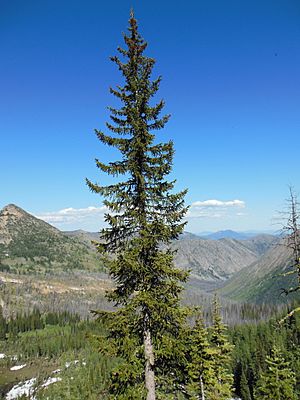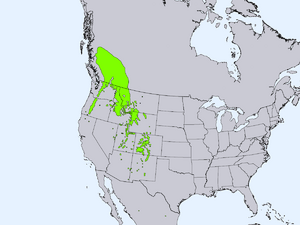Picea engelmannii facts for kids
Quick facts for kids Picea engelmannii |
|
|---|---|
 |
|
| Mature tree with female cones | |
| Conservation status | |
| Scientific classification | |
| Genus: |
Picea
|
| Species: |
engelmannii
|
 |
|
The Engelmann spruce is a type of spruce tree. It is also known as white spruce, mountain spruce, or silver spruce. This tree grows naturally in western North America. You can find it from central British Columbia and southwest Alberta in Canada, all the way down to northern California, Arizona, and New Mexico in the United States. There are even two small groups of these trees in northern Mexico.
Engelmann spruces usually grow high up in the mountains. They can be found at heights from about 3,000 feet (900 meters) to 12,000 feet (3,650 meters) above sea level. In many places, they grow right up to the alpine tree line, which is the highest point where trees can grow.
Contents
What Does an Engelmann Spruce Look Like?
The Engelmann spruce is a medium to large evergreen tree. This means it keeps its needles all year round. These trees usually grow to be about 80 to 130 feet (25 to 40 meters) tall. Some can even reach an amazing 213 feet (65 meters) tall! Their trunks can be as wide as 5 feet (1.5 meters).
The bark of the tree is thin and flaky. It peels off in small, round pieces. When the trees are young, their tops (called the crown) look like a narrow cone. As they get older, the crown becomes more like a cylinder.
The branches have small bumps called pulvini. The leaves are like needles, about 0.6 to 1.2 inches (15 to 30 mm) long. If you cut a needle in half, it would look like a diamond shape. The needles are a blue-green color. They have tiny holes called stomata on both sides.
Cones and Seeds
The cones of the Engelmann spruce hang down from the branches. They are long and thin, about 1.5 to 3 inches (4 to 8 cm) long. When they are closed, they are about 0.6 inches (1.5 cm) wide. When they open up, they can be about 1.2 inches (3 cm) wide.
The cone scales are thin and bendy. They have a wavy edge. The cones start out reddish or dark purple. About 4 to 7 months after the tree is pollinated (when pollen helps make seeds), the cones turn pale brown. The seeds inside are black and tiny, about 0.08 to 0.12 inches (2 to 3 mm) long. Each seed has a thin, pale brown wing that helps it fly in the wind.
Where Do Engelmann Spruces Grow?
Engelmann spruces grow in many mountain ranges. You can find them at higher elevations in the Cascade, Monashee, Selkirk, and Rocky Mountains. They also grow in the highlands around the Interior Plateau.
How Young Spruces Survive
Young Engelmann spruce trees, called saplings, need water to survive. This is especially true in late winter and early spring when they are above the snow. When saplings are covered by snow, they don't lose much water.
But for trees that are not covered by snow, getting enough water from the soil is very important in late winter. This is when they start to lose more water through their needles. If there's not enough water in the soil, or if the ground is still frozen in windy areas, it can be hard for young spruces to grow in open spaces. Strong winds can also damage their needles with ice, especially at the tree line. At lower elevations, drying out from lack of water is a bigger problem.
Different Kinds of Engelmann Spruces
There are two main types, or subspecies, of Engelmann spruce. Some scientists think they are just different varieties, while others think they are separate species.
- Picea engelmannii subsp. engelmannii (Engelmann spruce): This is the most common type, found across most of the tree's range.
- Picea engelmannii subsp. mexicana (Mexican spruce): This type is found in two separate groups on high mountains in northern Mexico. One group is in Coahuila and the other is in Chihuahua. Some scientists also think the Engelmann spruces in the mountains of Arizona and New Mexico might belong to this subspecies.
Engelmann spruces can also mix and create hybrids with other closely related spruce trees. They often mix with the white spruce (Picea glauca) in the Rocky Mountains. They also sometimes mix with the Sitka spruce (Picea sitchensis) where their growing areas meet in the Cascades.
How People Use Engelmann Spruces
The wood from Engelmann spruce trees is very useful. It is harvested to make paper and for general building projects. Wood from trees that grow slowly at high altitudes is special. It is used to make musical instruments like acoustic guitars, harps, violins, and pianos. These trees are also sometimes used as Christmas trees.
Who Eats Engelmann Spruces?
Sometimes, tiny insects called spruce beetles cause big problems for Engelmann spruce trees. These beetles can destroy millions of trees during large outbreaks.
Images for kids
See also
 In Spanish: Pícea de Engelmann para niños
In Spanish: Pícea de Engelmann para niños













